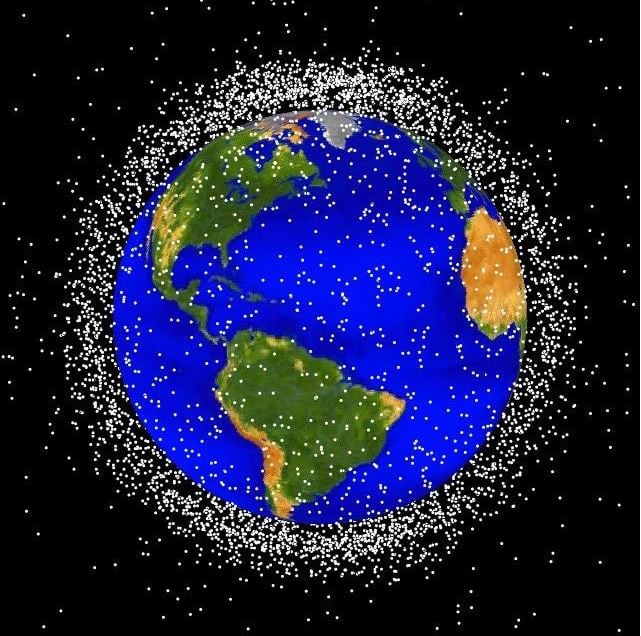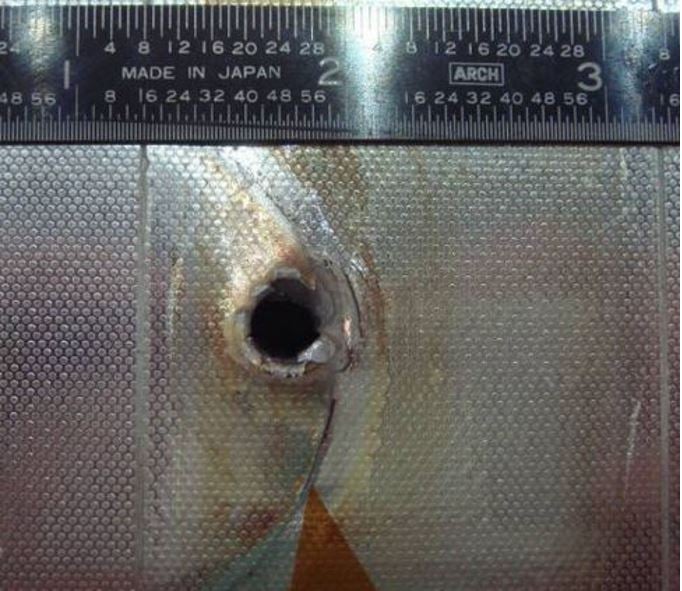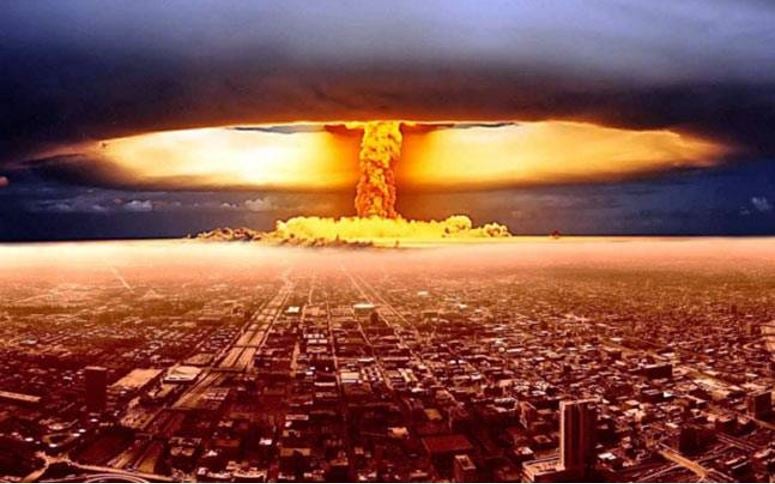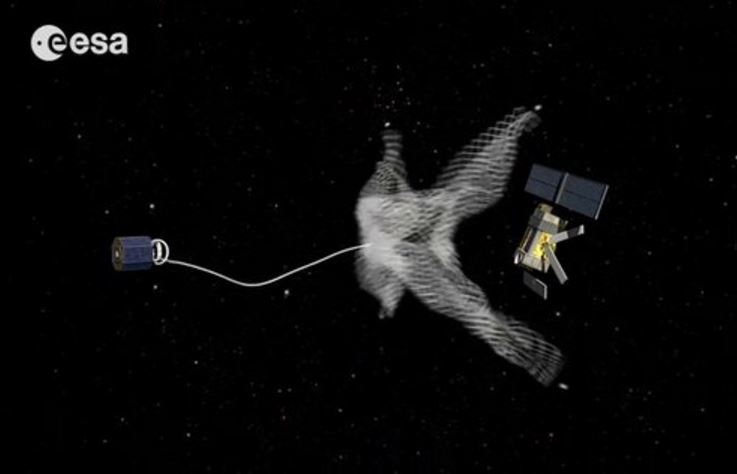There is so much space junk out there orbiting the Earth that there is a serious and growing risk it could trigger the Third World War, or a major political or military conflict, a Russian scientist, Vitaly Adushkin, has warned in an article soon to be published in the academic journal Acta Astronautica.
Adushkin, who works at the Russian Academy of Sciences’ Institute of Geosphere Dynamics, worries that if nothing is done, the ever-increasing levels of space junk – there are over 20,000 significant pieces of space debris out there – humankind’s fate will be in growing danger. A significant piece, according to NASA, is something bigger than a softball.
Apart from the WWIII risk, there is also the danger to property, equipment and human lives when these pieces of debris come back and crash on the Earth’s surface.
 Simulations of orbital space junk show that removing large items of debris, such as an entire derelict satellite, should help to stabilise the population and prevent cascading collisions. ESA has carried out a system study for an Active Debris Removal mission called e.DeOrbit. (Image: www.esa.int)
Simulations of orbital space junk show that removing large items of debris, such as an entire derelict satellite, should help to stabilise the population and prevent cascading collisions. ESA has carried out a system study for an Active Debris Removal mission called e.DeOrbit. (Image: www.esa.int)
Collisions with spy satellite and paranoia are a bad mix
Many countries have their own fleet of sophisticated spy satellites. Adushkin says that if one of them were destroyed by a piece of space junk, it would be extremely difficult to firstly prove whose debris caused the impact, and secondly, whether it really was unintentional and not a deliberate attack.
This is not just a doom and gloom scenario, Adushkin points out. There have been many known cases of military satellites suddenly going offline for no reason.
The fear of satellites, especially military spy ones, being targeted by rival and enemy nations, perpetuates a state of paranoia that fuels the process to dangerous confrontations and brinkmanship, and perpetuates the growing risk of military conflict.
In 2007, China’s military decided to test one if its anti-satellite missiles by destroying one of its own old weather satellites. This little experiment resulted in an explosion in space, which added 3,000 more pieces of debris out there.
The total number of pieces of space junk orbiting Earth – of all sizes that we are able to track – stands at about 500,000, ranging from tiny paint flecks to football-sized objects.
They whizz around our planet at more than 17,000 miles per hour, which makes even a seemingly harmless paint fleck a dangerous projectile for a spacecraft, satellite or astronaut on a spacewalk.
Just in 2014, the ISS (International Space Station) had to make five critical course alterations to avoid being struck by pieces of incoming space debris.
 An artist’s impression of some of the space junk that orbits the Earth. (Image: www.nasa.gov)
An artist’s impression of some of the space junk that orbits the Earth. (Image: www.nasa.gov)
So what can we do about it?
Several solutions are currently in place. Even though none of them would solve the problem completely, thanks to technological advancements, we are slowly getting there.
The European Space Agency’s e.Deorbit mission, which came through the agency’s Clean Space initiative, aims to remove derelict satellites from orbit.
This ESA (European Space Agency) mission is tasked with reducing the environmental impact of the space industry on both the orbital and terrestrial realms.
According to ESA, the space debris problem is one that is self-perpetuating and growing, because every time space objects crash into each other and break into hundreds of fragments, the number of individual potentially hazardous space junk items in orbit gets bigger.
 Space Shuttle Endeavour had a major impact on its radiator during STS-118. The entry hole is about 1⁄4 inch wide, and the exit hole is twice as large. (Image: Wikipedia)
Space Shuttle Endeavour had a major impact on its radiator during STS-118. The entry hole is about 1⁄4 inch wide, and the exit hole is twice as large. (Image: Wikipedia)
Conserving the heavily trafficked and valuable low cost orbits calls for the removal of the larger objects at a higher risk of collision, says ESA.
e.Deorbit will target an ESA derelict object in this region, grab it, then safely burn up both the satellite and the device sent out to destroy it through a controlled atmospheric re-entry.
After proving that this approach is effective, several missions could be flown each year. Hence, ESA is designing an e.DeOrbit device with recurring flights in mind.
In space industry talk, e.Deorbit has completed its “Phase-A’ preliminary analysis that began in January 2014. With many aspects already finalised, it is now moving on to ‘Phase-B1.”
The current aim is to bring e.Deorbit to a point where it is effectively ready to build if ESA’s Council of Ministers in December 2016 give it the green light for launch in 2021.
A number of studies in ESA’s Concurrent Design Facility have already put forward defined aspects of the missions, which would adapt a Vega rocket upper stage as a platform for its space debris-grabbing system.
 A Third World War with nuclear weapons (without them would be unlikely) would mean the end of our civilization on Earth.
A Third World War with nuclear weapons (without them would be unlikely) would mean the end of our civilization on Earth.
Missions would use nets or robotic arms
Researchers ruled out harpooning the target, and preferred alternative capture options including nets or robotic arms.
They have also ruled out an earlier prospect that involved taking space objects to higher, quieter orbits – they prefer downward de-orbiting.
Robin Biesbroek, who is managing the effort, said:
“I am very pleased with the progress we are making. In this phase we will really go into detail on the concept of operations, e.Deorbit’s subsystems design, and especially the capture and deorbit phases.”
“Extensive simulations will be done not only for standard cases, but also for off-nominal cases.”
ESA aims to bring down the danger to people on the ground from space junk to a risk of less than 1 in 10,000.
e.Deorbit’s next big milestone will be its ‘systems requirements review’, which is due in May/June 2016.
 Albert Einstein said “I know not with what weapons World War III will be fought, but World War IV will be fought with sticks and stones.” (Image: Wikipedia)
Albert Einstein said “I know not with what weapons World War III will be fought, but World War IV will be fought with sticks and stones.” (Image: Wikipedia)
However, in the long-term, the best solution is prevention. Elon Musk’s rockets do not leave junk in space – they come back and are used again and again. His company, Space X, aims to have a rocket which comes back exactly as it was when it blasted off.
NASA’s view on space junk
NASA made the following comment on its website regarding space debris:
“More than 500,000 pieces of debris, or “space junk,” are tracked as they orbit the Earth. They all travel at speeds up to 17,500 mph, fast enough for a relatively small piece of orbital debris to damage a satellite or a spacecraft.”
“The rising population of space debris increases the potential danger to all space vehicles, but especially to the International Space Station, space shuttles and other spacecraft with humans aboard.”
“NASA takes the threat of collisions with space debris seriously and has a long-standing set of guidelines on how to deal with each potential collision threat. These guidelines, part of a larger body of decision-making aids known as flight rules, specify when the expected proximity of a piece of debris increases the probability of a collision enough that evasive action or other precautions to ensure the safety of the crew are needed.”
 ESA plans to grab space junk objects with a large net. (Image: www.esa.int)
ESA plans to grab space junk objects with a large net. (Image: www.esa.int)
Space debris includes both artificial (man-made) and natural (meteoroid) objects. Meteoroids orbit the Sun, while nearly all artificial debris orbits the Earth. Hence, the latter is more commonly called orbital debris or space junk.
NASA says orbital debris includes any man-made object in orbit around our planet which is no longer in use.
Examples of such debris include mission-related debris, fragmentation debris, abandoned launch vehicles stages, and non-functional spacecraft and satellites.
Apart from 20,000 significant pieces and about half-a-million pieces of debris the size of a marble or larger, there are literally millions of debris pieces that are so small they cannot be tracked, NASA says.
Several of NASA’s space shuttle windows had to be replaced because of damage caused by material that was found to be paint flecks.
Nicholas Johnson, NASA chief scientist for orbital debris, said “The greatest risk to space missions comes from non-trackable debris.”
With so much space junk out there, NASA says it is amazing there haven’t been more major collisions.
Anna Kucirkova writes an interesting article in industrial-ovens.net titled “Is Space Junk Polluting Space Before We Even Live There?”
Kucirkova warns:
“Ultimately, space will become impassable because of the continuous cascade of colliding debris, including destruction of telecommunications systems and nullifying of further space launches.”
ESA Video – Space Debris Story
This ESA video explains how we ended up with so much space junk orbiting the Earth.
